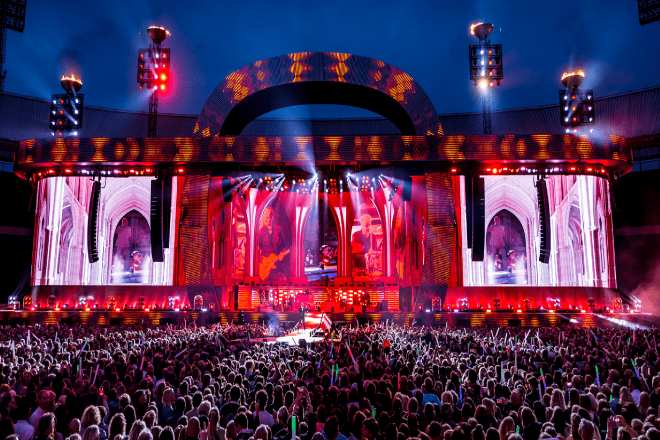Introduction

Lorsque vous entrez dans un lieu de divertissement populaire, avez-vous déjà été profondément attiré par le côté coloré et dynamique de l'endroit ? Affichage LED?
Ce n’est pas seulement un écran mais aussi l’âme de tout l’espace, qui peut instantanément enflammer votre enthousiasme et vous y immerger.
Mais le saviez-vous ? Derrière ces écrans apparemment simples se cachent en réalité de nombreuses conceptions et technologies ingénieuses. Comment les rendent-ils si attrayants ?
Table des matières
Méthode 1 : Réglage dynamique de la couleur et de la luminosité de l'écran LED
1). Stratégie de changement de couleur
Lorsqu'on joue avec un écran LED, le changement de couleur est un véritable défi. Passer des tons froids aux tons chauds est extrêmement critique.
Les tons froids comme le bleu et le violet semblent très calmes et mystérieux, ce qui convient aux occasions calmes.
Par exemple, dans un bar tard dans la nuit, tout le monde se détend, et l'ambiance ressort lorsque les tons froids sont allumés.
Si on passe à des tons chauds, comme le rouge et l'orange, la sensation est complètement différente.
Passionné et actif, il est particulièrement adapté au point culminant du concert, qui peut remplir l'atmosphère d'un coup.
Un autre avantage intéressant est la transition de couleur en dégradé. L'écran LED permet une transition fluide et progressive d'une couleur à l'autre, sans brusquerie.
Par exemple, il passe lentement du bleu au violet puis au rouge, et on dirait que les couleurs coulent.
Cet effet est particulièrement bon pour organiser performances. Suivant le rythme de la musique, les couleurs changent lentement, ce qui est particulièrement dynamique visuellement et confortable à regarder pour le public.
2). Luminosité capacités d'adaptation
Le réglage de la luminosité est également très important. En termes simples, il s'agit d'« observer l'environnement et d'ajuster la luminosité ».
Pendant la journée ou dans des endroits lumineux, l'écran d'affichage doit être plus lumineux ; sinon, l'image paraîtra floue.
La nuit ou dans les endroits sombres, la luminosité doit être diminuée, sinon le spectacle sera trop éblouissant et inconfortable pour le public.
Une autre astuce amusante est le changement dynamique de luminosité. La luminosité peut être ajustée en fonction du rythme de la musique ou de l'activité.
Par exemple, lors d'un festival de musique, lorsque le rythme de la musique est rapide, la luminosité de l'écran d'affichage est augmentée et l'image est plus percutante.
Lorsque le rythme musical est lent, la luminosité est réduite et l'image plus douce. Ainsi, la vision et l'ouïe sont parfaitement coordonnées, et le public se sent plus à l'aise pour regarder et écouter.
Méthode 2 : Conception de l'écran de contenu dynamique de l'écran d'affichage LED
1). Conception d'images à contenu dynamique sur écran LED
Pour que l'écran LED soit attrayant, il faut le faire bouger ! Par exemple, les images peuvent changer plus rapidement ou les animations peuvent être plus fluides pour un rendu captivant.
Tout comme regarder une courte vidéo, les images changent de temps en temps, ou les animations sont aussi fluides que du thé au lait soyeux, et le regard du public est immédiatement captivé.
De plus, le fait que les images se déplacent rapidement ou lentement dépend du rythme de l’activité.
Si la musique live est super excitante, les images doivent suivre l'excitation, comme des motifs clignotants rapides ou des images en mouvement rapide, qui donnent aux gens l'impression que toute la personne est motivée.
Mais si l’activité est relativement apaisante, comme une performance littéraire, les images peuvent se déplacer lentement, comme des nuages flottant lentement ou des parchemins se déployant lentement, ce qui est très confortable à regarder.
En bref, la vitesse des images doit correspondre au rythme des activités pour que le public puisse se sentir satisfait.
2). Sélection du contenu de l'image
Le contenu des images est également essentiel, et vous devez choisir ce que le public aime.
Par exemple, les motifs abstraits et les figures géométriques, bien que simples, sont très intéressants à modifier.
Par exemple, un simple triangle qui devient plus grand et plus petit, ou quelques cercles qui sautent d'avant en arrière, semblent très vivants.
Par exemple, les éléments populaires sont également très utiles. Désormais, les films, musiques et jeux préférés de chacun peuvent être utilisés.
Par exemple, des scènes classiques de films populaires ou les noms de chanteurs populaires sont affichés de manière animée, et le public peut les reconnaître en un coup d'œil et se sentir particulièrement familier.
Le plus cool est d'afficher l'image en direct en temps réel, comme la performance sur scène ou l'interaction du public dans le public.
Ce genre d'image peut donner au public le sentiment qu'il n'est pas laissé pour compte, comme s'il faisait également partie de la performance, et le sens de la scène est directement tiré au maximum !
Méthode 3 : Synchronisation visuelle et intégration de la musique et de l'affichage LED
1). Combinaison parfaite de musique et d'écran LED
De nos jours, la technologie est puissante et permet de synchroniser parfaitement musique et images. Cet effet est vraiment génial !
Par exemple, certaines technologies peuvent analyser le rythme de la musique en temps réel.
Si le rythme de la musique est rapide, le changement d'image sur l'écran s'accélérera également, tout comme le rythme cardiaque qui s'accélère, ce qui rend les gens particulièrement excités.
Si le rythme de la musique ralentit, l'image devient douce et apaisante, comme un ruisseau qui coule lentement, ce qui est particulièrement confortable.
Cette combinaison est particulièrement harmonieuse, tout comme la musique dirige l'image, permettant au public de profiter à la fois de la vue et de l'ouïe.
Une autre chose particulièrement amusante est de transformer les notes ou le rythme de la musique directement dans l'image.
Par exemple, lorsque les notes sautent, le motif à l'écran saute également. Lorsque le rythme est soutenu, l'image scintille ou des effets spéciaux intéressants apparaissent, comme des points lumineux, des ondulations, etc.
Cet affichage visuel permet au public non seulement d’entendre la musique mais aussi de « voir » la musique, ce qui est très intéressant !
Par exemple, lors d'un concert, lorsque le chanteur atteint le point culminant, l'image à l'écran devient soudain particulièrement éblouissante et les notes jaillissent comme un feu d'artifice. C'est une sensation vraiment bouleversante !
2). Musique différente, images différentes
Pour différentes musiques, l'image de l'écran doit également être modifiée en conséquence afin qu'elle soit adaptée.
Par exemple, pour la musique rock, l'image doit utiliser des couleurs particulièrement fortes, comme le rouge et le noir, puis assortir les effets cool, comme les éclairs et les flammes.
Il existe également des motifs abstraits qui font immédiatement ressortir le côté sauvage de la musique rock.
Imaginez que dès que la musique retentit sur scène, l'image sur l'écran ressemblait à une éruption volcanique, avec des flammes rouges et des éclairs noirs entrelacés, et le public était instantanément enflammé !
S'il s'agit de musique électronique, l'image doit utiliser des couleurs froides telles que le bleu et le violet, ainsi que des lignes douces et des formes géométriques, qui semblent particulièrement futuristes et technologiques, particulièrement adaptées à l'atmosphère de la musique électronique.
Par exemple, des rayons bleus apparaîtront à l'écran pour faire des allers-retours, ou des formes géométriques violettes continueront de se déformer. On se croirait dans le futur, c'est vraiment génial !
La musique pop est encore plus simple, utilisant directement des éléments populaires, tels que des images de dessins animés populaires et des mouvements de danse populaires.
Associé à des couleurs vives et des images décontractées, vous pouvez créer une atmosphère détendue et joyeuse afin que le public puisse s'amuser ensemble !
Par exemple, des images de stars populaires ou des personnages d'anime populaires apparaîtront à l'écran, dansant au rythme de la musique.
Ou alors des animations de paroles populaires apparaîtront, et le public se sentira familier en un coup d'œil, et il est facile d'être attiré par elles et de se balancer avec elles !
En bref, la combinaison de la musique et des images doit être basée sur l’occasion et le style musical afin que le public puisse vraiment s’y immerger et profiter d’un festin audiovisuel !
Raison 4 : Introduction des fonctions interactives des écrans d'affichage LED
1). Introduction aux fonctions interactives des écrans LED
Désormais, les écrans d’affichage LED ne sont pas seulement utilisés pour afficher des images, mais également pour interagir avec le public, ce qui est très intéressant !
Par exemple, de nombreux écrans sont équipés de fonctions tactiles et le public peut toucher directement l’écran pour participer à l’interaction.
Par exemple, sur le site de l’événement, le public peut voter en touchant l’écran pour sélectionner son contenu préféré.
Ou laissez un message et écrivez vos idées sur l'écran ; vous pouvez même contrôler directement le contenu de l'écran, comme ajuster la couleur de l'écran ou changer de scène.
Cette interaction tactile donne au public le sentiment qu’il peut également participer au contenu de l’écran, ce qui est particulièrement engageant !
Ce qui est encore plus intéressant, c'est la technologie de reconnaissance gestuelle. Le public n'a pas besoin de toucher l'écran, il lui suffit d'utiliser des gestes pour contrôler les changements d'image.
Par exemple, agiter la main permet de passer à l'image suivante, ou de modifier l'effet de l'image par un simple geste, ce qui rappelle particulièrement une scène de science-fiction ! Cette technologie rend l'interaction plus naturelle et plus intéressante.
2). Fonction interactive du téléphone portable
La fonction interactive du téléphone portable est également très puissante ! De nombreuses applications mobiles ont été développées.
Et le public peut contrôler directement le contenu de l'écran d'affichage LED via son téléphone portable.
Par exemple, vous pouvez télécharger vos propres photos ou vidéos pour les faire apparaître sur grand écran ou choisir votre thème d'image préféré pour que l'écran affiche l'effet souhaité.
Cette fonction est particulièrement adaptée aux jeunes, et chacun peut facilement participer via son téléphone portable.
L'interaction avec les réseaux sociaux est également présente. Désormais, de nombreuses activités afficheront le contenu des plateformes telles que Weibo et Douyin en temps réel sur un écran LED.
Par exemple, les sujets d’actualité de l’événement, les photos en direct publiées par le public ou les commentaires intéressants peuvent tous apparaître directement sur le grand écran.
De cette façon, le public peut non seulement participer à l'interaction en direct mais aussi voir le partage des autres personnes, qui est particulièrement en direct et impliqué !
En bref, ces fonctions interactives font de l'écran LED non plus un écran froid mais une plateforme interactive à laquelle tout le monde peut participer, ce qui est particulièrement intéressant !
5. Conclusion
Après avoir lu ceci, pensez-vous que la conception et la technologie derrière l’écran LED sont vraiment étonnantes ?
Du changement de couleur à l'image dynamique, de la synchronisation de la musique à l'introduction de fonctions interactives, chaque détail est soigneusement conçu pour créer une atmosphère dynamique.
La prochaine fois que vous vous retrouverez dans un lieu de divertissement et que vous serez attiré par l'écran cool, vous pourriez aussi bien penser aux efforts qui se cachent derrière tout cela.
Enfin, si vous souhaitez en savoir plus sur les écrans LED, veuillez nous contacter.
